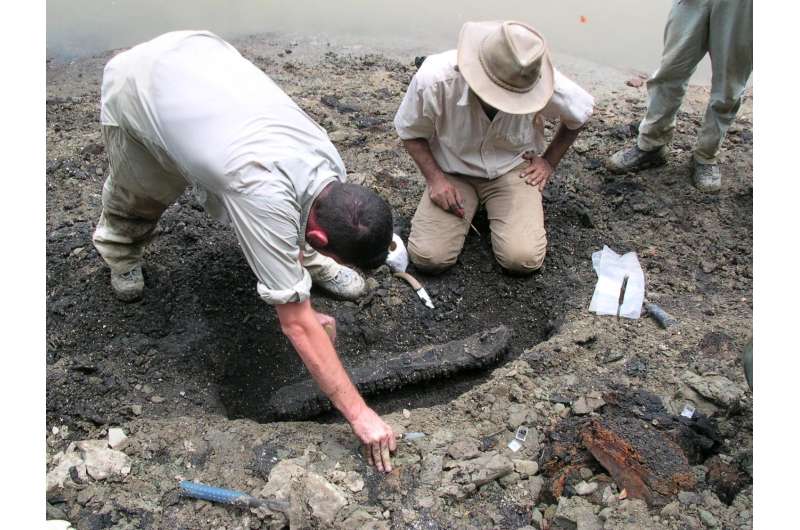Discovery of 13-million-year-old croc suggests parallel evolution of 'telescoping' eyes

Fossils of a 13-million-year-old extinct crocodilian from the Peruvian Amazon suggest that South American and Indian species evolved separately to acquire protruding, "telescoped" eyes that helped the animals conceal their bodies underwater while scanning the river's edge. The new study, published today in the journal PLOS ONE, provides a long-sought insight about the extremely long and slender-snouted gavialoids—one of the three major types of crocodilians, along with alligators and crocodiles—that are represented today by just one living species, the Indian gharial.
"The extraordinarily well-preserved fossils of this new 13-million-year-old gharial document how independent, parallel evolution of long-snouted animals with specialized visual systems occurred across continents," said John Flynn, Frick Curator of Fossil Mammals at the American Museum of Natural History and an author on the paper. "Continued paleontological exploration of the Amazon Basin is essential for discovering fossils that reveal more about the origins and history of tropical South America's extraordinarily rich modern biological communities and habitats."
Known for their elongated, narrow snouts, and sharp, piercing teeth, gavialoids are a diverse group of mostly extinct crocodilians that lived in an array of tropical regions including in South America and India. Many of the evolutionary relationships between these species remain unclear. Fossils of gavialoid crocodilians from South America and the modern Indian gharial, Gavialis gangeticus—the sole survivor of the lineage—have similar telescoped eyes, but it was not known how these features evolved.
![Time calibrated phylogenetic tree of the Gavialoidea and relevant paleogeographic distributions associated with the evolution and diversification of gavialoids in marine and freshwater settings.During the Late Paleocene-Early Eocene interval, peaks of sea surface temperature (SST) and global sea surface level (GSL) occurred together with tropical marine connections through the Tethys Ocean and Caribbean Sea [59,60]. During the Neogene, distinct biomes dominated tropical South America: (A) Acre Phase, after the onset of the eastern-draining Amazon and northward-draining Orinoco river systems; and (B) Pebas Mega-Wetland System, with its drainage northward to the Caribbean Sea. Abbreviations: Olig., Oligocene; Ple., Pleistocene; Pli., Pliocene. Global and South American schematic paleogeography adapted from Blakey [60] and Hoorn et al. [61], respectively. Credit: Salas-Gismondi et al. 13-million-year-old 'storyteller' crocodylian fossils show evidence for parallel evolution](https://scx1.b-cdn.net/csz/news/800a/2016/1-13millionyea.jpg)
Flynn has been co-leading prospecting and collecting expeditions with Peruvian paleontologist Dr. Rodolfo Salas-Gismondi and other colleagues at fossil outcrops of the Pebas Formation in northeastern Peru since 2002. These outcrops preserved a wide variety of ancient life from the Miocene era, and the group recently uncovered a hyper-diverse assemblage of at least seven different species of crocodilians in the Amazon bone bed, the largest number of croc species ever found co-existing in one place in any time in Earth's history.
Among these extraordinary fossils, the researchers found this new species. The oldest-known gavialoid crocodilian from the Amazon, it is named Gryposuchus pachakamue after Pachakamue, a pre-Hispanic South American "storyteller" god thought to have knowledge about the origins of South American life. The area where the researchers discovered the new gavialoid once contained a massive wetland system, filled with lakes, embayments, swamps, and rivers that drained north toward the Caribbean, before the eastward-draining Amazon River formed there. This distinctive habitat implies that the early gharial had a lake-dwelling lifestyle.
"Gryposuchus pachakamue was distinct from all the other crocodiles living in the vast Pebas Mega-Wetlands of northern South America," said Rodolfo Salas-Gismondi of the University of Montpellier in France and the Natural History Museum in Lima, Peru, and the lead author of the study. "This new gavialoid was the only long-snouted species within a hyper-diverse crocodile community dominated by blunt-snouted, clam-eating caimans."
The new analysis suggests that Gryposuchus pachakamue represents the ancestral condition from which the South American lineage evolved protruding eyes. This means that the distinctive eyes of gavialoids evolved in parallel in South American and Indian groups, at first showing just slight telescoping as seen in Gryposuchus pachakamue but eventually becoming fully telescoped during the evolution of other members of the lineage. Species of both the South American and Indian lineages later adopted a river-dwelling lifestyle, and it is likely that telescoped eyes were adaptive, helping them to catch fish in these habitats. Although further research is needed, this study provides an important foundation for furthering scientists' understanding of the evolution of all gavialoid crocodilians.
The American Museum of Natural History's new exhibition Crocs: Ancient Predators in a Modern World, which opens on May 28, features a photo of Flynn and Salas-Gismondi collecting a skull of Gryposuchus pachakamue in the field, along the banks of the Amazon River.
More information: Salas-Gismondi R, Flynn JJ, Baby P, Tejada-Lara JV, Claude J, Antoine P-O (2016) A New 13 Million Year Old Gavialoid Crocodylian from Proto-Amazonian Mega-Wetlands Reveals Parallel Evolutionary Trends in Skull Shape Linked to Longirostry. PLoS ONE 11(4): e0152453. DOI: 10.1371/journal.pone.0152453
Journal information: PLoS ONE
Provided by American Museum of Natural History


















